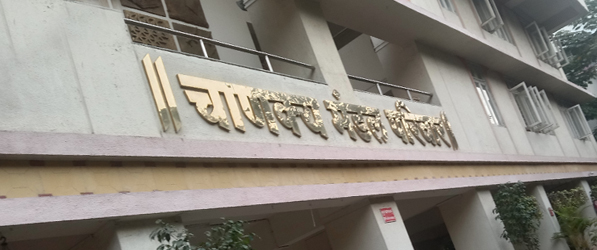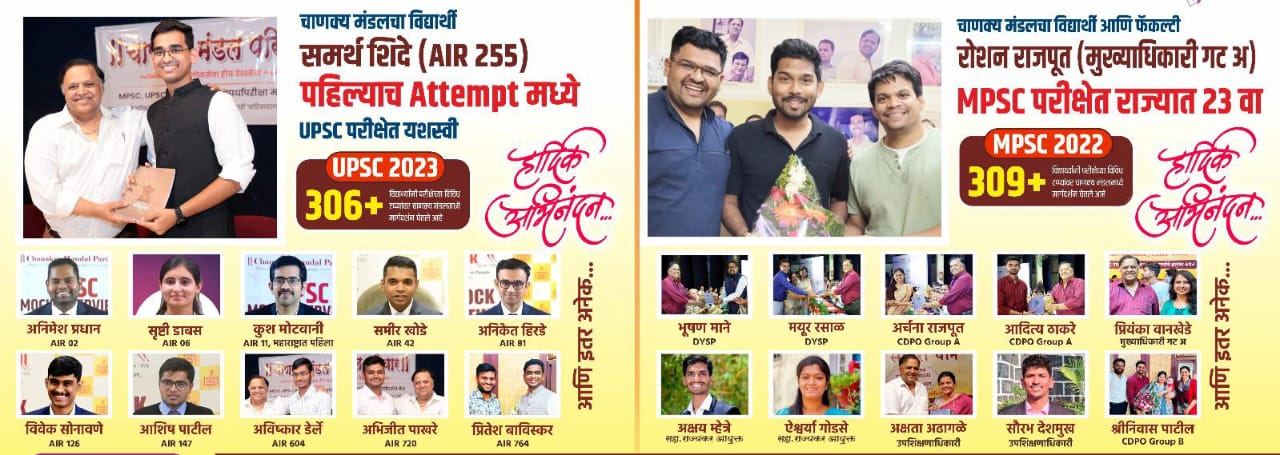Why “Chanakya”?
Arya Chanakya: Perhaps the pioneering prime bureaucrat- scholar. The thinker who realized the dangers of foreign invasion. Chanakya Mandal Pariwar has tried to awaken a corrupt exploitative, anti-people and inefficient regime. When the power-drunk corrupt regime refused to wake up, he sacrificed his career, went into wilderness organized and inspired the young generation from the commonest of the common strata of society.
He affected the political revolution which unified India and repulsed the foreign invasion. Having achieved all this he renounced all positions of power and wrote the eternal treatise ‘Artha Shastra’.
Economy - I Paper
खण्ड ‘A’ / Section A
1.
निम्नलिखित प्रत्येक प्रश्न का उत्तर लगभग 150 शब्दों में दिजिए :
Answer the following questions in about 150 words each :
(a) एकाधिकारात्मक प्रतियोगिता के अन्तर्गत चेम्बरलिन द्वारा प्रतिपादित अतिरिक्त क्षमता के विचार की संक्षेप में व्याख्या किजिए।
Explain briefly Chamberlin’s concept of excess capacity in monopolistic competition.
10
(b) ब्याज के तरलता अधिमान प्रारूप के अन्तर्गत ‘तरलता जाल’ के विचार की चर्चा किजिए।
Discuss the concept of ‘liquidity trap’ in the liquidity preference model of interest.
10
(c) मुद्रा की माँग में ‘लेनदेन दृष्टीकोण’ तथा ‘नकद शेष दृष्टीकोण’ के बीच प्रमुख अन्तर कौन-कौन से हैं ?
In demand for money, what are the major differences between ‘transaction approach’ and ‘cash balance approach’ ?
10
(d) ‘साधन किमतों में प्रचुरता’ तथा ‘साधन प्रचुरता’ के आधार पर व्यापार के साधन सम्पन्नता सिद्धान्त की चर्चा किजिए।
Discuss the Factor Endowment theory of trade in terms of ‘abundance in factor prices’ and ‘factor abundance’.
10
(e) हर्षमैन के अनुसार, असंतुलित विकास ‘सामाजिक उपरिव्यय पूँजी (SCO)’ अथवा ‘प्रत्यक्ष उत्पादक क्रियाओं (DPA)’ के माध्यम से किया जा सकता है। चर्चा किजिए।
According to Hirschman, unbalanced growth can be through ‘Social Overhead Capital (SOC)’ or ‘Direct Productive Activities (DPA).’ Discuss.
10
50
2.
(a) P = 100 – 2Q, MC = 10 और Q = q1 + q2
जहाँ P : बाजार मूल्य
Q : कुल उत्पादन/दोनों फर्मों के उत्पादन का कुल योग
q1 तथा q2 : प्रथम फर्म तथा द्वितीय फर्म का क्रमशः उत्पादन
MC : सीमान्त लागत
मान लिजिए प्रथम फर्म बाजार में नेतृत्व करती है तथा द्वितीय फर्म उसका अनुसरण करती है। पहले प्रथम फर्म अपना उत्पादन निर्धारित करती है तत्पश्चात् द्वितीय फर्म अपना उत्पादन निश्चित करती है। दोनों फर्मों का संतुलन उत्पादन, मूल्य तथा लाभ ज्ञात किजिए।
Consider a duopoly market,
P = 100 – 2Q, MC = 10 and Q = q1 + q2
Where P : Market price
Q : Total output or the sum total of both firms’ output
q1 and q2 : Firm 1 and Firm 2’s output respectively
MC : Marginal cost
Suppose Firm 1 is the market leader and Firm 2 is the follower. Firm 1 decides its output first and then Firm 2 takes its output decision. Find equilibrium output, price and profit of both the firms.
(b) यदी प्रथम फर्म मूल्य समायोजित करती, तो क्या उसे पहले प्रस्तावक का लाभ प्राप्त होता ? अपने उत्तर की व्याख्या किजिए।
Do you think Firm 1 would have had the first mover advantage if it had gone for the price adjustment ? Explain your answer.
(c) प्रतिस्पर्धी संतुलन पैरेटो कुशल और साम्यिक दोनों है। क्या आप सहमत हैं ? अपने उत्तर के औचित्य को स्थापित किजिए।
A competitive equilibrium is both Pareto efficient and equitable. Do you agree ? Justify your answer.
15
50
3.
(a) IS वक्र वस्तु बाजार के संतुलन बिन्दुओं का बिंदुपथ है। IS वक्र के उपर तथा नीचे के बिंदु क्या दर्शाते हैं ?
IS curve is the locus of equilibrium points in the commodity market. What do the points above and below the IS curve signify ?
15
(b) जमा गुणक की तुलना मुद्रा गुणक से किजिए। क्रेडिट और डेबिट कार्ड के प्रचुर उपयोग का मुद्रा गुणक पर क्या कोई प्रभाव पडता है ? अपने उत्तर के औचित्य को स्थापित किजिए।
Compare the deposit multiplier with the money multiplier. Is there any impact on the money multiplier arising out of massive use of credit and debit cards ? Justify your answer.
(c) पूर्ण पूँजी गतिशीलता एवं नम्य विनिमय दर सहित खुली अर्थव्यवस्था में मौद्रिक नीति की प्रभावशीलता की विवेचना किजिए। यदी अन्य स्थितीयाँ अपरिवर्तित रहें तो क्या स्थिर विनिमय दर में भी यह नीति प्रभावशाली रहेगी ? व्याख्या किजीए।
Discuss the effectiveness of the monetary policy in an open economy with flexible exchange rate and perfect capital mobility. Will this policy remain effective with fixed exchange rate also, while other things remain the same ? Explain.
20
50
4.
(a) करारोपण के सिद्धान्तों को बताइए। क्या आप समझते हैं की समान कर राजस्व उत्पन्न करने हेतु अप्रत्यक्ष करों की अपेक्षा प्रत्यक्ष कर कम बोझल होते हैं ? अपने उत्तर के औचित्य को स्थापित किजिए।
State the canons of taxation. Do you think that direct taxes are less burdensome than indirect taxes in generating equal amount of tax revenue ? Justify your answer.
(b) प्राथमिक शिक्षा – एक गुण (मेरिट) वस्तु, पर सार्वजनिक व्यय का आर्थिक औचित्य बताइए।
Give economic rationale for public expenditure on elementary education – a merit good.
(c) प्रतिष्ठीत तथा किन्सीय प्रारूपों में समग्र आपूर्ति वक्र का क्या आकार होगा ? विस्तृत व्याख्या किजिए।
What will be the shape of the aggregate supply curve in the Classical and Keynesian models ? Give detailed explanation.
15
50
खण्ड ‘B’ / Section B
5.
निम्नलिखित पर लगभग 150 शब्दों (प्रत्येक) में टिप्पणियां लिखिए :
Write notes on the following in about 150 words each :
(a) वितरण के काल्डर प्रारूप की प्रमुख मान्यताओं को स्पष्ट करते हुए सिद्ध किजिए की राष्ट्रीय आय में लाभ का हिस्सा कुल उत्पादन में निवेश के अनुपात पर निर्भर करता है।
Stating major assumptions in the Kaldor model of distribution, establish that share of profits in national income depends on the ratio of investment to total output.
10
(b) एक केन्द्रीय बैंक द्वारा साख नियंत्रण हेतु अपनाई गई परिमाणात्मक विधियों की व्याख्या किजिए।
Explain the quantitative methods of credit control adopted by the central bank.
10
(c) आंशिक संतुलन विश्लेषण के अन्तर्गत प्रशुल्क के उपभोग एवं राजस्व प्रभावों की चर्चा किजिए।
Under Partial equilibrium analysis, discuss the consumption and revenue effects of tariffs.
10
(d) डोमर के आर्थिक वृद्धी प्रारूप में साम्य की अवस्था में दर्शाइए की विनियोग पथ चरघातांकी होता है।
Show that in Domar’s growth model, in equilibrium, path of investment is exponential.
10
(e) नवीकरणीय संसाधनों के सन्दर्भ में प्रवाह तथा स्टॉक अवधारणा के मध्य अन्तर की उचित उदाहरणों सहीत चर्चा किजिए। क्या इन दोनों संसाधनों में से एक की उपलब्धता भविष्य की पीढीयों के उपभोग के लिए कम हो सकती है ? अपने उत्तर के औचित्य को स्थापित किजिए।
With appropriate examples, discuss the difference between the flow and the stock concept of renewable resources. Can the availability of one of these two resources be less for the consumption of future generations ? Justify your answer.
10
50
6.
(a) समर्थित संवृद्धि दर से आप क्या समझते है ? हरॉड के आर्थिक सवृद्धी प्रारूप में छुरी-धार असंतुलन की समस्या की व्याख्या किजिए।
What do you mean by the warranted rate of growth ? Explain the knife edge instability problem in Harrod’s growth model.
15
(b) आर्थर लुईस द्वारा प्रदत्त प्रारूप के अन्तर्गत श्रम की असीमित आपूर्ति के स्रोतों का संक्षिप्त उल्लेख किजिए तथा एक अल्प विकसित देश के अन्तर्गत दोहरी अर्थव्यवस्था के विकास हेतू क्रियाविधी समझाइए।
Following Arthur Lewis, briefly state the sources of unlimited supply of labour and explain the mechanism of development of a dual economy of a less developed country.
20
(c) लिंग विकास सूचकांक (GDI) एवं लिंग सशक्तीकरण माप (GEM) में अवयवों तथा निर्माण के आधार पर अन्तर्भेद किजिए।
Distinguish between Gender Development Index (GDI) and Gender Empowerment Measure (GEM) in terms of their components and constructions.
15
50
7.
(a) परिक्षण किजिए की क्या रिकार्डो के प्रारूप में तुलनात्मक लाभ का सिद्धान्त वास्तव में तुलनात्मक लागतों का सिद्धान्त बन जाता है।
Examine whether in Ricardian model, the theory of comparative advantage actually becomes a doctrine of comparative costs.
15
(b) मानक व्यापार प्रारूप के अन्तर्गत संरक्षण की अंकित (नॉमिनल) तथा प्रभावी दरों के मध्य अन्तर्भेद किजिए। मान लिजिए :
– आयातित वस्तु j हेतु अंकित प्रशुल्क 40% है,
– आगत i हेतु प्रशुल्क दर 40% है,
– आयातित आगत i का लागत हिस्सा, j वस्तु की कुल उत्पादन लागत का 0.5% है।
संरक्षण की प्रभावी दर का निर्धारण किजिए तथा इस सन्दर्भ में दर्शाइए की अंकित (नॉमिनल) प्रशुल्क दर एवं संरक्षण की प्रभावी दर एकसमान है।
Distinguish between nominal and effective rates of protection in Standard Trade Model. Suppose
– nominal tariff on imported good j is 40%
– tariff rate on input i is 40%
– cost share of imported input i in the total cost of production of commodity j is 0.5%.
Determine the effective rate of protection and show that in this case nominal tariff rate is equal to the effective rate of protection.
20
(c) जगदीश भगवती द्वारा प्रतिपादीत ‘इमीसराइजिंग ग्रोथ’ के सिद्धान्त की व्याख्या किजिए।
Illustrate Jagdish Bhagwati’s doctrine of ‘Immiserising Growth’.
15
50
8.
(a) व्यापार और विकास पर संयुक्त राष्ट्र सम्मेलन (अंकटाड) के कार्यो को लिखिए। क्या आप समझते है की विकासशील देशों के बीच आर्थिक सहयोग को बढाने में अंकटाड सफल रहा है ? अपने उत्तर के औचित्य को स्थापित किजिए।
State the functions of United Nations Conference on Trade and Development (UNCTAD). Do you think that UNCTAD has been successful in extending economic cooperation among the developing countries ? Justify your answer.
(b) विकासशील देश क्यों प्रदूषण की एक अनुज्ञेय सीमा एक प्रकार की सभी प्रदूषणकारी इकाइयों के लिए निर्दिष्ट करते हैं और उसे एकसमान रूप से लागू करते है ? इस तरह की नियंत्रण विधी से संबंधीत क्या-क्या समस्याएँ है ?
Why do developing countries rely on specifying a permissible level of pollution and impose it uniformly across all polluting units of the same kind ? What are the problems associated with such a control method ?
15
(c) COP (कॉन्फ्रेंस ऑफ पार्टीज) 26 की मुख्य सफलताएँ और असफलताएँ क्या है ?
What are the major achievements and failures of COP (Conference of Parties) 26 ?
15
50
 CTS
CTS  Donate
Donate 


